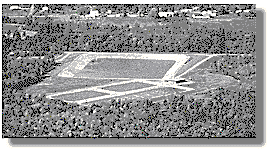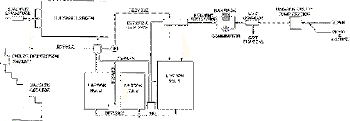|
North Berwick
Sanitary District

The
North Berwick Sanitary District has achieved their goal of
improving the water quality of the Great Works River through the
construction of a wastewater treatment facility for the Town of
North Berwick. The total project included the construction of
38,000 feet of sewer and force main, seven pump stations, and a new
wastewater treatment facility.
Prior to
construction of the new sewer system and wastewater treatment
facility, untreated sewage from the village of North Berwick was
discharged to the Great Works River creating nuisance and public
health concerns. Of particular concern were the adverse effects these
raw sewage discharges were having on the downstream impoundment of
Leighs Mill Pond.
After careful
evaluation of several treatment alternatives, Wright-Pierce selected
the aerated lagoon treatment process with seasonal discharge to the
Great Works River. This was found to be the most cost-effective means
to provide the required high level of treatment and to protect the
river and downstream impoundments.
Treatment of
wastewater in lagoons is one of the oldest, simplest and most reliable
treatment processes. Wastewater entering the lagoons is stabilized or
treated by several natural processes. Heavier solids settle to the
bottom where they are decomposed by bacteria. The lighter material is
broken down by bacteria in suspension. The large lagoon volume and
corresponding long wastewater detention times provide a high level of
treatment. However, even this highly treated effluent contains certain
plant nutrients that can contribute to algae blooms downstream.
To address these and other
concerns, Wright- Pierce incorporated several unique and innovative
design concepts in the new treatment facility including seasonal
discharge and hydrograph release (plant discharge correlated to stream
flow). North Berwick is one of the first large scale operating
seasonal discharge treatment facilities in the state. The treatment
facility includes a 38-million gallon storage lagoon that allows
storage (zero discharge) of treated sewage during the summer months of
the year. The lower river flows of the summer, combined with the high
water temperatures and long sunny days promote algae growth during
this period when discharge from the treatment facility will be
eliminated completely. During the higher river flows of the winter and
spring, discharged nutrients are greatly diluted and more readily
flushed through Leighs Mill Pond.
To provide the needed
air for the treatment lagoons, Wright-Pierce incorporated a new
"state- of-the-art" aeration system. The aeration system consists of
fine bubble porous plate diffusers that rest on the bottom of the
lagoons. The system was selected for its comparatively high
efficiency, low maintenance, flexibility and reliability.
The new
treatment facility and sewer system represents a major step in
restoring the natural water quality of the Great Works River and
Leighs Mill Pond. Initial plant start-up occurred in February 1987. A
combination of state, federal, and local funds were used to finance
the project with a total construction cost of $4.8 million
BASIC DESIGN DATA

|
Design Flow: |
0.230
MGD |
|
Peak Flow: |
1.150 MGD |
|
Design BOD Load: |
643
pounds per day
(38% Industrial, 62% Municipal) |
|
Design SS Load: |
708 pounds per day |
|
Total Lagoon Volume: |
45.6 MG |
|
Design Detention
Time: |
122 Days |
Flow Schematic


click the image
above to enlarge
Lagoon
Specifications

|
Lagoons |
No.1 |
No. 2 |
No. 3 |
Storage |
|
Volume |
3.5 MG |
1.8 MG |
1.8 MG |
38.3 MG |
|
Aeration |
Fine Bubble |
Fine Bubble |
Fine Bubble |
None |
|
Comments: Total lagoon
acreage is 10.9 acres or 474,804 square feet. Facility has (4) 25
horsepower blowers. Facility has a total of 3.5 acres aerated.
Aerator manufacturer is Environmental Dynamics, Inc. Aerator model
is the Reef I unit. Lagoons have a total of 106 diffusers.
|
System Information

|
Design Flow |
0.023 MGD |
|
Actual Flow |
0.095
MGD |
|
Discharge To |
Great
Works River |
|
Year Built |
1985 |
|
Design Engineers |
Wright
Pierce |
|
Septage Received |
No |
|
Collector System |
11 miles of gravity sewers, 146 manholes, 3 pump stations |
|
Staff Size |
3 Full
Time |
|
Number of Users |
475 |
|
Billing Software |
User Developed |
|
Comments |
Plant
operates in hold and release mode. No discharge from May 31st to
October 1st. Limited to 0.10 MGD from January 1st to March 15th. |
Contractors
Bridge Construction
Corporation
Augusta, Maine
S.E. MacMillan Co.,
Inc.
Bangor, Maine
P. Gioioso & Sons,
Inc.
Boston, Massachusetts
Back to Lagoons in
Maine
 |

